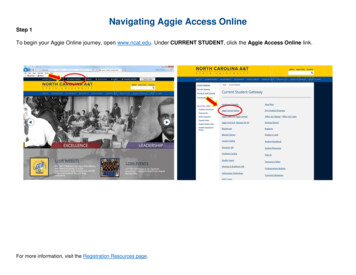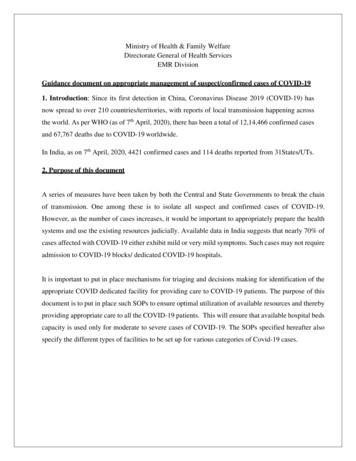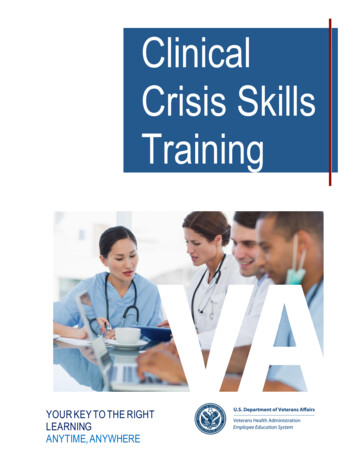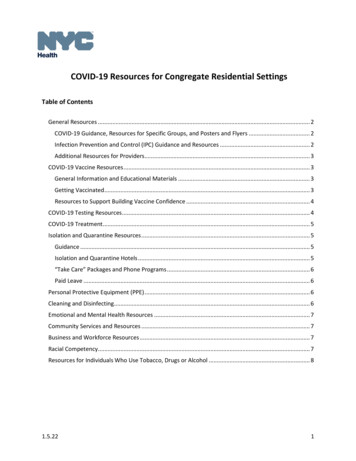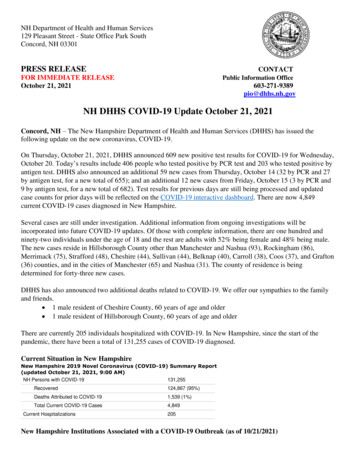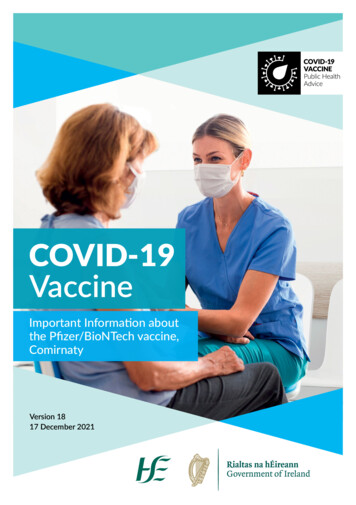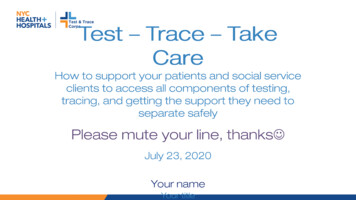
Transcription
NavigatingCOVID-19 ClinicalCare Pathways Acrossthe Health Care SystemA practical guide for primary health care workersMarch 2022
SUGGESTED CITATION: Meeting Targets and Maintaining Epidemic Control (EpiC).Navigating COVID-19 Clinical Care Pathways Across the Health Care System: A practicalguide for primary health care workers. Durham (NC): FHI 360; 2022.ACKNOWLEDGMENTSThe development of this guide was led by Emily Headrick MSN, FNP-C; Kate Douglass MD,MPH; and Mirwais Rahimzai MD, MPH (EpiC project and FHI 360). The authors would liketo thank Katherine (Megan) Kearns, Amit Chandra, Allison Ficht, Diedra Parrish, KondradBradley, and Carol Holtzman from USAID for their support and review. Moses Bateganya,Navindra Persaud, Steve Wignall, Nilufar Rakhmanova, Salomon Compaore, DonnaMaCarraher, Robert Makombe, Christian Pitter, Hally Mahler, and Harsha Rajashekharaiahprovided invaluable review. Andrea Surette led coordination of the guide. Editing and graphicdesign were provided by Sarah Muthler and FHI 360 Design Lab.The work is based on the most recent evidence and best practice experienceavailable at the time of publication. The work is aligned with and primarily based on theWorld Health Organization technical guidance on COVID-19, including the Therapeutics andCOVID-19: living guideline, as well as the U.S. Centers for Disease Control and Prevention(CDC) COVID-19 Guidance and the OpenCriticalCare.org project. OpenCriticalCare.org is a collaborative educational effort started by the World Federation of Societies ofAnaesthesiologists, the University of California San Francisco (UCSF) Anesthesia Divisionof Global Health Equity, the UCSF Institute for Global Health Sciences, and OPENPediatrics.It is led by UCSF under the USAID Sustaining Technical and Analytic Resources (STAR)project and is part of a broader collaboration with partners of USAID including FHI 360,Jhpiego, and Palladium.This work was made possible by the generous support of the American people throughthe United States Agency for International Development (USAID). The contents are theresponsibility of the EpiC project and do not necessarily reflect the views of USAID or theUnited States Government. EpiC is a global cooperative agreement (7200AA19CA00002)led by FHI 360 with core partners Right to Care, Palladium International, Population ServicesInternational (PSI), and Gobee Group.
TABLE OF CONTENTSIntroduction: Intended Audience and How to Use this Document. 1Section 1: General Information about COVID-19 . 4What is COVID-19?. 4How is it transmitted?. 4Infection prevention and control: The foundation of the COVID-19 response. 5Why is it important to slow the spread and reduce the impact of COVID-19?. 7Section 2: “I don’t feel well”: The First Step on the Pathway to Care. 10Self-assessment: It starts with the patient!. 10The next step: connecting patients to care. 13Using telehealth services to improve access to care. 15Seeking care at a primary health care facility. 17Section 3: Triage at the Health Care Facility. 21Why is triage important?. 21Physical triage and patient flow at a health care facility. 21Screening: physical and clinical triage. 21Triage challenges. 24Section 4: Approaching the Patient with Symptoms ofCOVID-19: Initial Clinical Assessment. 27Basic assessment and history of present illness. 27Physical exam for a confirmed or suspected COVID-19 patient. 29Differential diagnoses and considerations for assessing special populations. 32Section 5: Clinical Management for Mild and Moderate COVID-19. 37Basic management and support measures for mild COVID-19. 38Basic management and support measures for moderate COVID-19. 38Risk factors for development of severe disease. 41Check-ins and remote monitoring for COVID-19 patients in the community. 41Remote monitoring: what to ask. 42Mild to moderate COVID-19 in pediatric patients. 44
Mild to moderate COVID-19 in pregnant and postpartum patients. 44Other vulnerable and high-risk patients. 45Use of evidence-based therapeutics in the community and primary care setting. 46Section 6: Stabilization and Clinical Management of Patientswith Severe or Deteriorating COVID-19 . 49Definition and clinical presentation of severe COVID-19. 49Step-by-step care for severe COVID-19 patients. 49Therapeutics . 50Pediatric patients with severe COVID-19. 52Pregnant patients with severe COVID-19. 53Other vulnerable patients. 54Section 7: Appropriate Medical Use of Oxygen. 56Who needs oxygen and how much?. 58Target SpO2 levels. 58Oxygen therapy at home. 59Oxygen in a health care facility. 60Pediatric patients. 60Section 8: When and how to refer patients to a higher level of care . 62Destination planning. 63Transport. 63Handover. 63Case studies. 65Clinical and IPC considerations when arranging transportation. 66Section 9: Discharge Planning and Follow-Up Care:Returning to the Community after Hospitalization for COVID-19. 69Discharge planning with the interdisciplinary health care team. 69Follow-up by community health workers or other community support resources. 71Section 10: Care for patients with post-COVID-19 conditions. 73Post-acute COVID syndrome. 74Long COVID-19 and post COVID-19 conditions in primary care. 75
Section 11: Maintaining and Strengthening Essential Primary Care Services. 78Why is this important?. 78Connecting to comprehensive care. 79“Make your own roadmap:” a guide for developing your own care pathwayto help your community navigate COVID-19. 83Annexes: Supplemental Material. 89I. Example COVID-19 Screening Tool at a Health Facility. 89II. Triage Algorithms. 90III. Provider Communication Tools. 93A. Interfacility transfer checklist. 93B. SBAR communication template. 96IV: Essential Supplies for COVID-19 Response in Primary Care. 97V: COVID-19 Oxygen Escalation Algorithm. 99VI: Case Study Answers. 100Section 4 case studies. 100Case studies. 102References. 104
DEVELOPING ACARE PATHWAYModerate/SevereCOVID-19REHABILITATION SERVICES, MENTAL HEALTHSERVICES, SOCIAL SUPPORT SERVICES,DISCHARGE PLANNING, HBC/PHC AND PALLIATIVECARE SERVICESStabilize& DischargeFollow up with PHCCriticalCOVID-19 (ICU)PALLIATIVE CARE SERVICESClinicallyUnstableAdmit to hospitalPatient returns tocommunity &Primary HealthCare System forongoing needsDEATHTRIAGETRANSFER FROM HBC ORPHC TO HOSPITALTertiary CareEmergencyDepartment/HospitalRed Flag Signs ofSevere IllnessIdentified in person,via telehealth, orfrom communityStabilize& DischargeFollow up with PHCEDUCATION ONRED FLAG SIGNSFOLLOW UP PERHBC GUIDELINESOR“I don’t feelwell, I needmedical care.”Patient initiates anencounter with theHeatlh Care SystemSTART HERE“I’m ok, I justneed a test.”“I have a question,and just needinformation.”Medicalevaluation withPrimary HealthCare (PHC) ServiceSTRENGTHENSCREENING & TRIAGEConnect thepatient to resourcesfor local COVID-19information ortesting e, remoteclinical assessmentor informationOPTIMIZETELEHEALTHMild or ModerateCOVID-19Patient is stable& safe for homebased care (HBC)OR CONNECT WITHCOVID-19 NEGATIVE, MEDICAL NEEDS MET, CONNECTWITH VACCINATION & OTHER PHC SERVICES
ACRONYMSABGArterial blood gasBMIBody mass indexBPBlood pressureCFRCase Fatality RateCHFCongestive heart failureCHWCommunity health workerCOPDChronic obstructive pulmonary diseaseCVACerebrovascular accidentHRHeart rateICUIntensive care unitIPCInfection prevention and controlMIS-CMultisystem inflammatory syndrome in childrenNCDNoncommunicable diseasePPEPersonal protective equipmentSBARSituation, background, assessment, recommendationSP02Oxygen saturationTBTuberculosisTIATransient ischemic attackVLViral loadi
INTRODUCTIONIntended Audience and How to Use this DocumentThis document offers a framework that health care workers of all disciplines can use to navigatetheir health care system and serves as a guide to connect patients infected with and affected byCOVID-19 to comprehensive, high-quality, and equitable care.We aim to expand upon the established public health concepts and clinical management principlesof COVID-19 care to complement the broader infrastructure of services that must be consideredwhen coordinating comprehensive, high quality, and equitable care. We aim to offer practicaltechnical guidance for how to approach common challenges to assessment, clinical management,and care coordination for all patients seeking primary health care in the context of the COVID-19pandemic. As COVID-19 becomes endemic, strengthening systems to support the continuum ofcare is critically important, particularly maintaining—and strengthening—essential health services.While many clinical protocols and public health guidelines have been published since early 2020,there is a gap in the guidance for health care workers on how to integrate protocols to execute apractical and realistic plan of care within the complex ecosystem of health care service deliveryamid the COVID-19 pandemic. Many of the strategies and frameworks included in this guide areapplicable to patient care for those who do not have COVID-19, as essential health services for allpatients should be maintained throughout and beyond the pandemic. We intentionally focus onprimary care and community-based health care teams as the backbone of the health system andoften the first point of contact for patients with confirmed or suspected COVID-19. Most peoplewith COVID-19 can be managed at the primary care level, can recover safely at home, and do notrequire hospitalization. We aim to equip all health care workers at every tier of the health system withthe tools to safely triage, assess, and decide where patients need to go for the right care at theright time.1
This document is comprised of 11 sections and several additional tools and resources in theannexes. Each section can be used independently and expanded to develop a comprehensivemodule. However, the combined sections represent a practical guide along the pathways to clinicalservices including home-based care, acute care/receiving facilities, primary care facilities, andinpatient care.The intended audience of this document is any cadre of health care worker in the public or privatesector who is serving their communities. This includes: Physicians: general practitioners, medical officers, and specialists Nurses, midwives, and nursing assistants Clinical officers, advanced practice nurses, physician assistants, and othernon-physician providers Community health workers (CHWs) Private health sector clinical staff Social workers and mental health providers Pharmacists Clinic or hospital administrators, health program leaders, and health policy leaders Other community leaders involved in working to achieve epidemic control (faith-basedorganizations and groups, societal groups, school health groups, business organizations, etc.)The COVID-19 pandemic has had an immense effect on our lives, our patients, our communities,and our health care systems. We hope this document will provide guidance to health care workersat this moment in the pandemic and beyond, and that some of these tools will in turn strengthen thehealth care system and improve preparedness for future challenges.2
SECTION 13
SECTION 1:General informationabout COVID-19What is COVID-19?COVID-19 (short for coronavirus disease–2019)is an infectious disease caused by a new typeof coronavirus called SARS-CoV-2 (severeacute respiratory syndrome–coronavirus 2).The coronavirus family includes many types ofviruses. So far, seven of these coronaviruses areknown to cause disease in human beings(Figure 1). The first four are responsible forthe common cold. SARS-CoV (severe acuterespiratory syndrome) and MERS-CoV (MiddleEastern respiratory syndrome) caused seriousoutbreaks when they emerged in China (2002)and Saudi Arabia (2012), respectively.IN THIS SECTIONThis section will introduce readers toCOVID-19, the infectious disease thathas caused a global pandemic andchallenged health systems in waysthe global community has yet to fullymeasure or understand. In this section,readers will: Understand the basic principles ofCOVID-19 virology and pathophysiologyas a novel infectious disease Discuss infection prevention and control(IPC) as a general principle and explainwhy it is a foundational component ofCOVID-19 response Explain the systemic impact of theCOVID-19 pandemic beyond morbidityand mortalitySARS-CoV-2, the virus responsible for the currentpandemic, was discovered in late 2019 and continues to affect every country across the globe.Several subtypes, or variants, have been identified since the start of the pandemic (e.g., Deltavariant, Omicron variant). These variants have arisen from mutations in the virus’ genetic code,but all are considered the SARS-CoV-2 virus.SARS-CoV-2 presents several unique and profound challenges. It is a new virus to humankind;therefore, no human has pre-existing immunity. Because of specific features of the virus includingits transmissibility, its ability to be transmitted without or prior to symptoms, and its severity in somepopulations, it quickly spread across the globe and caused immense strain on health resources.Our health systems have not had to handle the effects of a global respiratory pandemic since theglobal influenza pandemic more than 100 years ago.How is it transmitted?An infected person can spread the virus through the tiny droplets (or very small airborne particles)of moisture released from the nose or mouth when she or he is breathing, sneezing, coughing,speaking, or singing. These virus-containing droplets remain in the air or fall on nearby surfaces,like a person’s hands, shared utensils, or high-touch surfaces in a common living space.A healthy person can become infected with the virus when the person inhales virus-containingdroplets emitted from another person’s mouth or nose. It is also possible to become infected ifcontaminated surfaces (like hands or shared utensils) come in contact with the mouth, nose, or eyes.It is important to understand that some infected people can be contagious—actively spreading thevirus and possibly infecting other people—without showing symptoms of illness.4
FIGURE 1. Types of coronaviruses known to infect humansSEVEN KNOWN CORONAVIRUSES TO INFECT HUMANS229ENL63OC43HKU1SARS-COVzzCOMMON COLDzz2002-03outbreakin China 8,000cases in5 countriesCFR: 10%50% whodied were 65 yearsMERS-COVzzz2012outbreak inSaudi Arabia 019outbreakin China229million cases4.7 milliondeathsCFR: VariesIPC: the foundation of the COVID-19 responseWhen we understand how viral infections spread between people, we can prevent contaminationand control the spread—and thus the impact—of an outbreak of a disease like COVID-19.IPC has been an important part of health care for many years. What is it, and why is it so important inthe fight against COVID-19?Infection prevention and control (IPC) is a practical, evidence-basedapproach preventing patients and health workers from being harmed byavoidable infections. Effective IPC requires constant action at all levelsof the health system, including policymakers, facility managers, healthworkers and those who access health services. IPC is universallyrelevant to every health worker and patient, at every health careinteraction. Defective IPC causes harm and can kill. Without effective1IPC it is impossible to achieve quality health care delivery.World Health Organization1. World Health Organization. Infection prevention and control. Available from: tion-and-control.5
Preventing infection and controlling the spread of the virus will protect our communities and ourhealth care systems from being overwhelmed. Many local governments have implemented IPCmeasures, and these recommendations should be observed. Preventing the spread of the virus iseveryone’s responsibility, and these simple IPC actions can make a big difference.IPC AT HOME Get vaccinated against COVID-19 if you are eligible, and encourage your friends and familyto get vaccinated as well. Check your local guidelines for updated information on COVID-19immunization, including recommendations for and availability of booster doses. Wash your hands for at least 30 seconds with soap and warm water several times a day,especially after coughing, sneezing, wiping your nose, using the restroom, changing diapers,and before and after eating. If soap and water are not readily available, you may also regularly sanitize your hands with analcohol-based hand sanitizer—a great option when traveling or on the go! Ensure that high-touch surfaces, like door handles and countertops, are disinfected regularly. Promote adequate ventilation at home; this may include opening windows or redirecting airflowin the home. Be mindful of IPC when welcoming visitors into your home; ask them if they are having anysymptoms and consider rescheduling the visit if they are feeling unwell. You may considerrequesting that visitors wear masks if gathering in your home, or you may prefer to keep yourvisits outside where you can distance in a well-ventilated, open-air space. If someone in your home is sick, follow the local guidelines for isolation and/or quarantine(see Section 2).IPC IN THE COMMUNITY Wear a mask over your mouth and nose when in public areas, especially indoors, or inaccordance with local guidelines Wash or sanitize your hands regularly in public, especially after using doors, after trips tothe bathroom, and before and after eating, drinking, or removing your mask. Advocate forwell-positioned hand hygiene stations at the places you frequent regularly in the community(i.e. your places of work, education, worship, or commerce). Avoid crowds or large gatherings of people, especially if there is low mask usage in the crowd. Maintain physical distancing wherever possible (minimum 6 feet, or about 2 meters) inpublic areas. If you feel sick or have been notified that you’ve been exposed to COVID-19, do not go intothe community; self-isolate per your local guidelines, and get tested. Every eligible person should get vaccinated against COVID-19 as soon as they are able.Community leaders and health care workers should get vaccinated themselves and advocatefor vaccination in their communities. Check your local guidelines for updated information onCOVID-19 immunization, including recommendations and availability of booster doses.6
IPC AT A HEALTH CARE FACILITYEach health facility must have a clear and well-designed IPC plan so that potentially infectiouspatients can access care without putting health workers or other patients at risk. IPC plans for healthcare facilities must include the following considerations: Redesign patient flow in the health facility to have separate areas for potentially contagious(“sick”) patients and patients without possible COVID-19 symptoms. Make all health care workers aware of workflows; promote regular refresher trainings for healthcare workers on IPC workflows, protocols, and guidelines. Strengthen triage with screening at all points of entry to direct patients to the appropriate area ofthe facility for care. See Section 3 for more detailed information on this. Enforce universal masking for all people entering the clinic. Make appropriate personal protective equipment (PPE) available for health care workers to safelyrender care to anyone who meets the case definition for COVID-19. Position hand hygiene stations at multiple areas throughout the facility, and heavily promote handhygiene among staff and people entering the health facility. Promote daily symptoms checks for all staff at the health facility; promote workplace policies thatallow staff members to report their symptoms, self-isolate, get tested, and get care if they are ill.Why is it important to slow the spread and reduce the impactof COVID-19?COVID-19 is the illness caused by the SARS-CoV-2 virus, and it causes asymptomatic or mild tomoderate cold or flu-like symptoms in the vast majority of the population. However, in some cases,it can cause serious illness leading to hospitalization and death, and this happens at a much higherrate than with other viral illnesses. Even though the percentage of people with COVID-19 who getsevere disease leading to hospitalization is comparatively low, the more people in a communitywho get COVID-19, the higher the relative number of complications requiring hospitalization that willarise. This virus can spread very quickly, and thus can quickly overload health facilities, overwhelmhealth care workers, and have ripple effects on the health systems’ ability to care for all people—withor without COVID-19.So, why is it important to slow the spread and reduce the impact of COVID-19? Reducing morbidity (sickness) and mortality (death): By following the basic measures toprotect yourself from getting the disease, you also protect your family, your friends, and yourcommunity. Even though most people who get COVID-19 will not develop complications, reducingthe overall caseload in the community reduces the number of people who get severe illness andrequire hospitalization. Maintaining essential health services: The primary health care system needs to continueroutine services (like antenatal care, immunizations, and chronic disease management) to keepcommunities healthy. The pandemic has disrupted these services, which will have lasting effectson the long-term health of populations.7
Protecting our civilinstitutions: The COVID-19pandemic has affected almostevery facet of our lives. Thesooner we can reduce theburden of sickness and deathin our communities, the fasterour schools, our economies,and our health care systemscan recover.Health care workers in thecommunity and in primary carecenters are well positioned tokeep most of their patients safeat home; only about 10-15%of patients with COVID-19 willneed any type of hospital care(Figure 2). By guiding patientsto the right care at the righttime and place, we can saveour resources in the hospitalsand critical care centers for thesickest patients.FIGURE 2. Distribution Across the Continuum of COVID-19 CareCritical Care / ICU5-10% of those evaluated in the hospital will develop severeCOVID-19 and require critical care. The fewer people contractCOVID-19 means fewer critically ill patients.Hospital Care10-20% of patients will need evaluation and care at a hospital, mostly toadminister medical oxygen therapy. You may see patients coming directlyfrom the community, or referred from the primary care center.Primary Care & Community Care60-70% of concerns can be managed at the primary care level.Encourage patients to contact the primary care center first for information,evaluation and guidance from a nurse or doctor.80-90% of patients can get tested and, if positive, self-isolate at home. Symptoms aremild, self-limiting, and you can treat them like you would a common cold or flu.EXPAND YOUR KNOWLEDGE WITHKEY REFERENCES: National Institutes of Health. Clinical spectrum of SARS-CoV-2 ih.gov/overview/clinical-spectrum/ World Health Organization: Technical Guidance, Infection Prevention & Control. icationtypes d198f134-5eed-400d-922e-1ac06462e6768
SECTION 29
SECTION 2:“I don’t feel well”: The First Stepon the Pathway to CareSelf-assessment:It starts with the patient!All patients start their pathway to care byassessing their own situation and deciding toengage with the health care system in some way.A new symptom or concern usually initiates anindividual’s engagement with the health caresystem, whether a cough, shortness of breath,fever, or possible exposure.IN THIS SECTIONCommunity based health workers will Begin to understand what it meansto “become a patient,” and the manypossible ways people in the communitybecome patients and engage withthe health system to seek health careservices. Identi
SUGGESTED CITATION: Meeting Targets and Maintaining Epidemic Control (EpiC). Navigating COVID-19 Clinical Care Pathways Across the Health Care System: A practical guide for primary health care workers.


